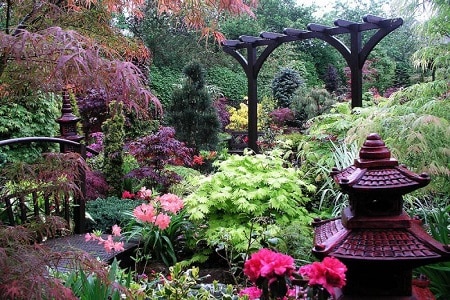by Andrew Pacholyk, MS, L.Ac.
Feng Shui (pronounced Fung Shway) is the ancient Chinese art of placement to enhance the flow of “vital life energy” known as Qi. Practitioners believe that rooms, buildings and all environments can be arranged and decorated in a way that maximizes the flow of Qi and resulting in improvements to health and happiness of those who live in that environment. Although the translation of Feng Shui basically means “Wind and Water“, its scope and breathe are much deeper than this. We Feng Shui our homes and our office, burial grounds and schools, the garden is another place that lends great balance to our lives.
I often like to introduce the Five Element Phase Theory into a garden setting. This natural progression just seems to make so much sense. The Five Phases (Elements) Theory, which states there are five interrelated elements: fire, earth, metal, water and wood is one of Feng Shui’s oldest and respected theories.
The following are the ways (or cycles) in which the elements are interrelated. These are the two balanced/physiological cycles:
“Sheng”-Generating/Nourishing (Creative) Cycle
In this cycle, one element generates/nourishes or creates the
following element. The nourished element is also known as the child
element. The nourishing element is known as the mother element. This
is an important aspect of Feng Shui and Traditional Chinese
Medicine. The pattern is:
* Fire nourishes earth
* Earth nourishes metal
* Metal nourishes water
* Water nourishes wood
* Wood nourishes fire
“Ke”-Controlling (Destructive) Cycle
Even as each element nourishes another, it also controls an element.
The controlling element is sometimes referred to as the grandmother
element. This cycle is as follows:
* Fire controls metal
* Metal controls wood
* Wood controls earth
* Earth controls water
* Water controls fire
Each element has a direction, which can help in dividing the garden into five directions and corresponding elements. By looking at the elements that are in the different areas, we can then see if an element is missing from a particular direction. It is also a possibility that a controlling element is present, which can therefore cause the element for that direction to be weakened. For example, fire’s direction is south, so a pond or fountain located in the south of the yard would severely weaken the fire element.
Water’s direction is north. Wood’s directions are east and southeast. Fire’s direction is south. Earth’s directions are northeast, southwest and the center. Metal’s directions are west and northwest.
Elements may be adjusted by adding the appropriate color of plant, element or shape to the area. Therefore, water may be assisted by adding a fountain in the north. Red flowers in the south would enhance fire. A wind chime in the west and white flowers in the northwest would enhance the metal element. Tall, thin trees in the east and a wooden arbor in the southeast can be used to strengthen wood. A stone sculpture as the centerpiece of the garden with yellow flowers in the northeast and decorative rocks in the southwest would
add the balancing touch.
Here is a good reference chart of “cures” for the elements:
The Wood Element
* All plants
* Wooden furniture, decks, fencing, and pathways
* Arbors, wooden gazebos, trellises
* Rattan and wicker
* Stripes and floral prints
* Columnar and long, thin shapes
* Blues and greens
The Fire Element
* All lighting, including oil, electrical, and candles
* Fireplaces and barbecues
* Pets and wildlife
* Statuary and garden art depicting people and animals
* Triangular and conical shapes
* Reds
The Earth Element
* Brick, tile, and adobe
* Earthenware pots and garden art
* Square and rectangular shapes
* Yellows and earth tones
The Metal Element
* Metal furniture, fencing, and statuary, sculpture
* Metal wind chimes
* Rocks, stones, and sand
* Circular, oval, and arched shapes
* White and pastels
The Water Element
* All water features: birdbaths, fountains, ponds
* Reflective surfaces, such as glass, crystal, and mirrors
* Asymmetrical, free-form shapes
* Black and dark tones
As a general fact: most gardens already tend to have an over abundance of Wood element in them. Try to balance out this element with aspects of each of the other elements.
If you are confused as to which items to use in each direction, I highly believe in meditating on it. Sit in front of your garden. Cross your legs in a comfortable nature and close your eyes. Take several deep breaths in and slowly out through your nose. Take your time and simply visualize your perfect garden. What feels “right ” to you? At some point Listen to the sounds around you. At some point Smell the air around you. Allow your intuition to guide you.
Breath. Take your time. 5 minutes, 7 minutes, 15 minutes. Let your mind quiet. At your own pace, slowly open your eyes.
This is a great way to visualize what you really want. Then, when you go back and compare it to the “cures” chart above you may be surprised as to how “right” you have allowed your instincts to be!





